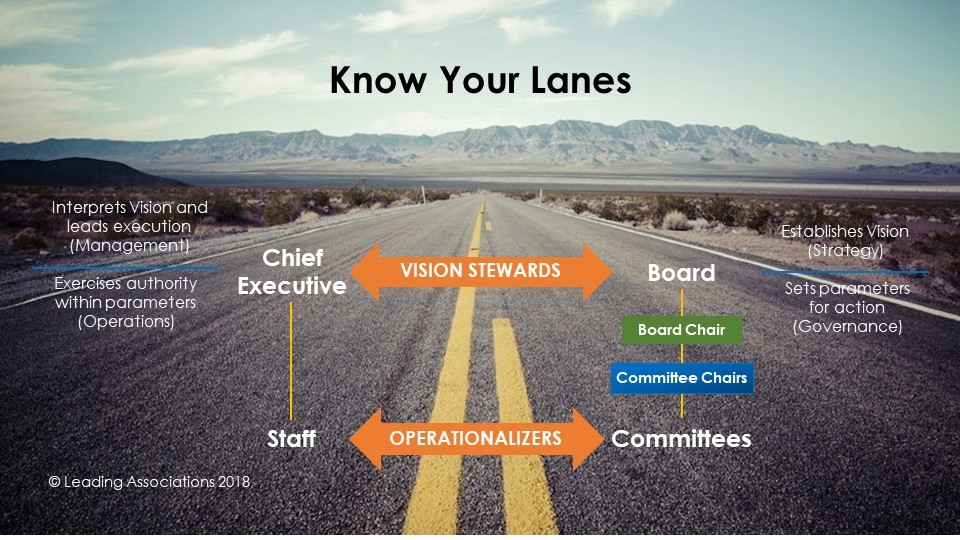 Challenges in board/staff relationship generally arise from three types of board engagement: disengaged, over-engaged, or engaged in the wrong way. Let’s look at each area, then explore key strategies for overcoming the challenges presented.
Challenges in board/staff relationship generally arise from three types of board engagement: disengaged, over-engaged, or engaged in the wrong way. Let’s look at each area, then explore key strategies for overcoming the challenges presented.
Disengaged
Staff with a disengaged board may see it as a blessing or a curse, depending on the degree to which the organization is staff-driven and the strength of the Chief Staff Executive (CSE). The board may have fallen into a passive role because a strong executive “trained” them to be passive, or by default because it lacks strong leadership or experience among its members. Or, the board lacks meaningful work and clear roles and responsibilities.
Board meetings in such organizations are typically staff-driven, perhaps even “chaired” by the chief staff executive more so than the chief elected officer. Staff report out what they’re working on. Board members listen passively to staff and committee reports. The extent of board engagement is to ask clarifying questions once in a while: “what was the date of the conference, again?” Most board decisions/votes are rubber-stamps of staff recommendations.
Generally speaking, though, most association executives want strategic direction from the board. Without it, they either take their best guesses at where they think the organization should go, or stay in an operationally reactive mode, perhaps rudderless. While a strong staff may be a driver of this dynamic, it may also arise from a lack of understanding by the board of its roles and responsibilities in strategy and governance.
Over-Engaged
On the flip-side, if the board is over-engaged, staff feels micromanaged, board meetings get deep into operational discussions and tend to be much longer than they should be. Organizations with over-engaged boards often became that way for one or more of the following reasons:
- The board recently transitioned from an all-volunteer organization to employing an executive (or hired an executive after previously having an administrative assistant), so they’ve been accustomed to managing daily operations as well as governing;
- Board members have operational-level day jobs, so that’s the mindset they bring to the board;
- The organization has a shallow pool of volunteers, so board members take on what should be committee-level responsibilities; and/or
- The board got “burned” by a previous executive and feels the need to watch organizational operations more closely.
Regardless of the cause, the board is managing, rather than governing, the organization. This creates inefficiency, as the board is duplicating the work of the staff or taking on committee-level responsibility, not doing the work it should be doing as a board.
Engaged in the Wrong Way
What is the “wrong kind” of engagement? The list is long. But in summary, it is engagement that is a reflection of the board’s own dysfunctional interpersonal/cultural dynamics being translated into its relationship with staff (or vice versa).
Staff often becomes the fall guy for board dysfunction – collateral damage, if you will. But that said, staff is not immune to or above petty politics that may play out on the board. They may even become part of it – or worse, the source of it. Some examples of dysfunctional board/staff engagement include:
- A divisive board member may be just as difficult in their interactions with staff as they are with board members, maybe more so. Frustrated staff may inappropriately react.
- A common deflection tactic for an underperforming board member is to throw staff under the bus to shift the focus off of themselves (usually when the staff person isn’t there to defend themselves).
- Staff may be their own worst enemy by choosing sides when a board becomes factional. If their side ends up on the losing end, so do they.
- Sometimes executives pick favorites, operating under the belief: “If I pack the board with my friends, I’m safe.” Board members who aren’t the “chosen ones” generally see through this and resent it, which may eventually lead to a shift against the executive.
On that note, a piece of advice I got from a fellow executive is “the members are not your friends.” If a board member is truly a good board member, they will take action in the best interest of the organization, which may mean firing you even if they are your friend. The best path to long-term employment is being competent, serving the best interest of the organization, staying true to your values, and staying above the politics – not packing the board with your friends.
How to Establish the “Right Kind” of Board/Staff Engagement
So what’s the “right kind” of board engagement with staff? The strategies to address the three challenges in board/staff engagement are:
- Disengagement > Stay in your lanes and establish meaningful work and meaningful roles;
- Over-Engagement > Establish the board’s trust in staff’s competence and/or delegate committee-level responsibilities;
- Engaged in the wrong way > Get your house in order
Stay In Your Lanes
Lack of engagement by the board/over engagement of staff has at its root a lack of meaningful work or a meaningful role for the board. The problem is that either the board or staff are straying outside of their respective lanes or staying in the shoulder. To stay in your lane on the highway, you need to see the lines painted on the road. Similarly, with board/staff relationships, the way to avoid collisions is to know where the lines are.
The board’s lane is setting strategic direction and governing. The staff’s lane is interpreting and executing the board’s strategic direction and managing operations. (See the header graphic in this article.)
There is plenty of work to be done in the board’s lane; if the staff moves into the board’s lane (providing strategic direction, setting policies) or the board is stuck on the shoulder because it doesn’t know what lane to drive in, then the board will struggle to find meaningful work and become a rubber-stamper of staff initiatives.
Trust Instead of Micromanagement
If the board’s behavior is a legacy of previous experience, get clear on that and get over it. Live in the present moment. If your current staff is competent, get the heck out of operations. If you’re doing committee-level work, expand your volunteer bench strength and delegate. Shift your focus to directing and governing, not doing or scrutinizing the work of the organization.
If the board feels compelled to micromanage staff, the real issue is a lack of trust in the executive’s competence. If that’s the case, the board needs to exercise one of its key responsibilities – hiring and evaluation of the executive.
Get Your House in Order
If the board/staff relationship is strained by any or all of the three categories of dysfunction detailed in my previous article “Overcoming Board Dysfunction and Optimizing Function: A Simple Framework,” employ the strategies outlined therein.
My general advice to staff is to recognize board dysfunction and personally stay clear of it. Let it stay between and among board members. Do not become part of the problem. Especially avoid being a willing participant – or worse, an instigator.
As staff, don’t try to mediate volunteer-to-volunteer conflict; that’s the board chair’s job. If the board leadership won’t “own” the problem (or is the problem), bring in an outside facilitator if necessary, but don’t let yourself get in the middle (refer to previous paragraph on “collateral damage”).
Ultimately, the board needs to take ownership of its culture. If staff has become part of the culture, the executive needs to identify where this is happening and extricate staff from the equation. Seek outside counsel and expertise if necessary, but continuing to engage in a reactive cycle (i.e., doing the same thing over and over), certainly won’t change the dynamic.

